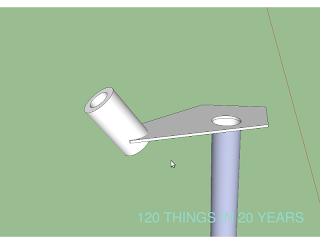I tend to strive for 2nd best practice anyway, so it's all good. Here is what I did.
First up I cut some blades out of a 30cm cardboard clingwrap tube.
I used about a quarter of a tube for each blade.
I made the first cut straight along the tube, and the next cut from a quarter of the tube away. Cut to one centimetre away from the first cut at the tip.
That's not so clear. If they look a bit like the picture they will probably work. I wasn't too fussy with angles and things because this wont matter if it falls to bits.
I'd be fussy with the real thing, because vibration will be an issue.
Next I delicately removed some excess bits of an old computer chip fan (I used a hammer and a screwdriver), so that I could mount the blades on it and use it as a bearing. It would have been possible to even generate a small amount of electricity if this fan wasn't broken.
It turns out, many electric motors will produce electricity if you rotate them.
And then a drop of super glue to mount the blades in place.
In this case, my blades will be rotating clockwise.
As mentioned in a previous post on blade twist, the leading edge bits that sticks out from the centre line in the middle of the blades, are there because we want a steep angle of attack, and a fatter blade profile at the centre. This is because a given spot near the centre moves slower than a given spot at the tip.
I cut a tail out of cardboard, and screwed it onto a stick. The total tail length should be around the length of one of your blades.
From what I've read, the tail area should be somewhere around 15% of the swept area of the blades.
So 16% of pi X (blade length X blade length)
But I just cut something that looked about right.
I drilled a hole through the stick so it wouldn't split when I put a nail through it. The nail will be the pivot point for the tail.
The nail goes through on an angle of around 20 deg, so that the bottom points away from the tail.
Like this, as seen in the first post on this genius system of furling.
Now all we need to do is make a base plate with a few holes drilled in it to mount everything on.

It should look like this.
But instead of a pipe set at an angle I just drilled a hole at an angle through some wood.
Mine looked like this with the computer chip fan bearing mounted.
To create the angles required, and to make your tail do the right thing as described in the post called genius furling, there are a few angles and dimensions to get right.
- Picture a square (black)
-mark out a 50 deg angle (green)
-and weld a pipe on a 20 deg angle (yellow), pointing back along the line made by the 50 deg angle.
This creates an offset between the turbine and the tail.
-this offset (blue) should be around 5% of the length of one blade.
What all this does, is makes your tail and the offset blades try to meet in strong winds because the tail is always trying to point down wind. This means the blades turn away from the wind, thus protecting them from spinning too fast and either burning out all your wiring, or total catastrophic destruction of everything. The weight of the tail resists this meeting, because it has to move up if its to move to the side, due to the 20 deg angle. Adjusting the weight of the tail adjusts the wind speed required to furl the system.
Ingenious. (and sadly not my idea)
It's described better in the post I called genius furling.
Here is a video showing the test turbine working. This video shows the angles a bit better than the last as I attached a drinking straw pointing straight back at 90 deg to the blades. Especially in the last few seconds of the video, the straw shows the angle of the turbine in relation to the tail as the wind speed changes (using a fan). The wind direction stays the same throughout the video.






No comments:
Post a Comment